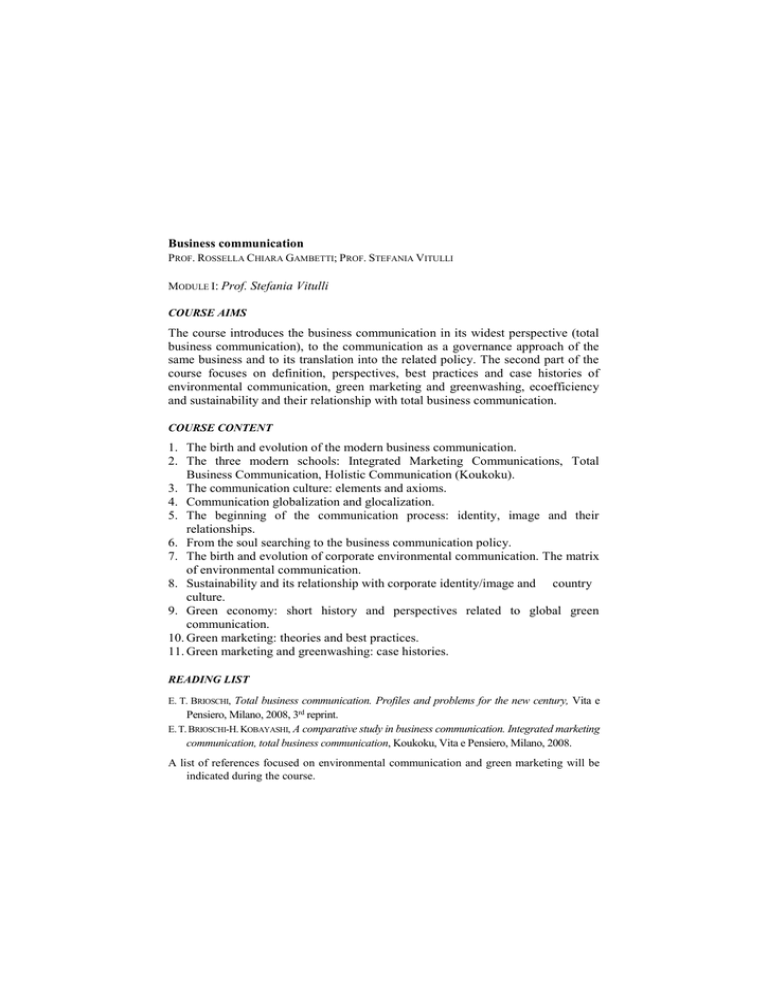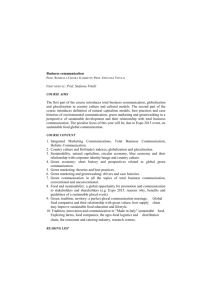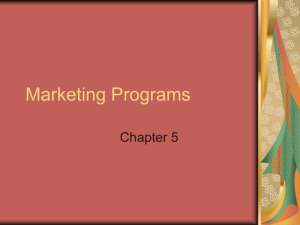
Business communication
PROF. ROSSELLA CHIARA GAMBETTI; PROF. STEFANIA VITULLI
MODULE I: Prof. Stefania Vitulli
COURSE AIMS
The course introduces the business communication in its widest perspective (total
business communication), to the communication as a governance approach of the
same business and to its translation into the related policy. The second part of the
course focuses on definition, perspectives, best practices and case histories of
environmental communication, green marketing and greenwashing, ecoefficiency
and sustainability and their relationship with total business communication.
COURSE CONTENT
1. The birth and evolution of the modern business communication.
2. The three modern schools: Integrated Marketing Communications, Total
Business Communication, Holistic Communication (Koukoku).
3. The communication culture: elements and axioms.
4. Communication globalization and glocalization.
5. The beginning of the communication process: identity, image and their
relationships.
6. From the soul searching to the business communication policy.
7. The birth and evolution of corporate environmental communication. The matrix
of environmental communication.
8. Sustainability and its relationship with corporate identity/image and country
culture.
9. Green economy: short history and perspectives related to global green
communication.
10. Green marketing: theories and best practices.
11. Green marketing and greenwashing: case histories.
READING LIST
E. T. BRIOSCHI, Total business communication. Profiles and problems for the new century, Vita e
Pensiero, Milano, 2008, 3rd reprint.
E. T. BRIOSCHI-H. KOBAYASHI, A comparative study in business communication. Integrated marketing
communication, total business communication, Koukoku, Vita e Pensiero, Milano, 2008.
A list of references focused on environmental communication and green marketing will be
indicated during the course.
MODULE II: Prof. Rossella Chiara Gambetti
COURSE AIMS
The course is aimed at analysing the brand concept and the basic dimensions
related to branding from a communicational perspective, with a particular focus on
innovative branding strategies carried out by companies to engage consumers in
longlasting relationships with their brands.
COURSE CONTENT
The brand and the innovative branding strategies towards consumer-brand
engagement
1. The concept of brand, its evolutionary features, its basic advantages offered to
consumers and companies.
2. Brand positioning and brand equity.
3. Consumer-brand engagement and consumer touch-points.
4. Innovative branding strategies:
– Experiential branding.
– Branded entertainment.
– Brand as a social platform: brand communities and beyond.
– Unconventional branding: ambient and guerrilla marketing communication.
READING LIST
For attending students
J.J. BRAKUS-B.H. SCHMITT-L. ZARANTONELLO, Brand experience: what is it? How is it measured?
Does is it affect loyalty?, Journal of Marketing, 73, 2, 2009, pp. 52-68.
L.P. CARBONE-S.H. HAECKEL, Engineering customer experience. Marketing Management, 3, 3, 1994,
pp. 9-19.
A.F. FIRAT-C.J. SHULTZ, From segmentation to fragmentation. Markets and marketing strategy in the
postmodern era, European Journal of Marketing, 31, 3-4, 1997, pp. 183-207.
A.F. FIRAT-A. VENKATESH, Liberatory postmodernism and the re-enchantment of consumption,
Journal of Consumer Research, 22, 3, 1995, pp. 239-266.
R.C. GAMBETTI, Ambient communication: how to engage consumers in urban touchpoints.
California Management Review, 52, 3, 2010, pp. 34-51.
R.C. GAMBETTI-G. GRAFFIGNA-S. BIRAGHI, Grounded theory approach to consumer-brand
engagement: practitioners’ standpoint, International Journal of Market Research, 54, 5, 2012,
pp. 659-687.
C. HACKLEY-R. TIWSAKUL, Entertainment marketing and experiential consumption, Journal of
Marketing Communications, 12, 1, 2006, pp. 63-75.
E.C. HIRSCHMAN-M.B. HOLBROOK, Hedonic consumption: emerging concepts, methods and
propositions, Journal of Marketing, 46, 2, 1982, pp. 92-101.
M.B. HOLBROOK-E.C. HIRSCHMAN, The experiential aspects of consumption: consumer fantasies,
feelings and fun, Journal of Consumer Research, 9, 3, 1982, pp. 132-140.
A.M. MUNIZ-T. O’GUINN, Brand community, Journal of Consumer Research, 27, 4, 2001, pp. 412-
432.
C.K. PRAHALAD-V. RAMASWAMY, Co-opting customer competence. Harvard Business Review, 78, 1,
2000, pp. 79-87.
B.H. SCHMITT, Experiential marketing. Journal of Marketing Management, 15, 1999, pp. 53-67.
S. WHELAN-M. WOHLFEIL, Communicating brands through engagement with ‘lived’ experiences.
Journal of Brand Management, 13, 4-5, 2006, pp. 313-329.
For non-attending students
Books
E.T. BRIOSCHI-H. KOBAYASHI, A comparative study in business communication. Integrated marketing
communication, total business communication, Koukoku, Vita e Pensiero, 2008, Milano.
R. GAMBETTI-S. QUIGLEY, Managing corporate communication: a cross-cultural approach, Palgrave
MacMillan, London, 2012 (Chapters 1, 2, 4, 5, 6, 9, 10, 12, 13, 14, 18, 19 and 20).
Articles
L.P. CARBONE-S.H. HAECKEL, Engineering customer experience. Marketing Management, 3, 3, 1994,
pp. 9-19.
R.C. GAMBETTI, Ambient communication: how to engage consumers in urban touchpoints,
California Management Review, 52, 3, 2010, pp. 34-51.
R.C. GAMBETTI-G. GRAFFIGNA-S. BIRAGHI, Grounded theory approach to consumer-brand
engagement: practitioners’ standopoint, International Journal of Market Research, 54, 5, 2012,
pp. 659-687.
C. HACKLEY-R. TIWSAKUL, Entertainment marketing and experiential consumption, Journal of
Marketing Communications, 12, 1, 2006, pp. 63-75.
M.B. HOLBROOK-E.C. HIRSCHMAN, The experiential aspects of consumption: consumer fantasies,
feelings and fun, Journal of Consumer Research, 9, 3, 1982, pp. 132-140.
B.H. SCHMITT, Experiential marketing, Journal of Marketing Management, 15, 1999, pp. 53-67.
Optional readings
K.L. KELLER, Strategic brand management: building, measuring and managing brand equity,
Pearson Prentice Hall, Upper Saddle River, 2008.
TEACHING METHOD
Interactive lessons, group assignments and oral presentations.
ASSESSMENT METHOD
Final written exam, evaluation of group assignments, project works, and oral
presentations.
NOTES
It is foreseen a separate evaluation at the end of every module.







